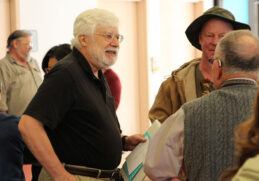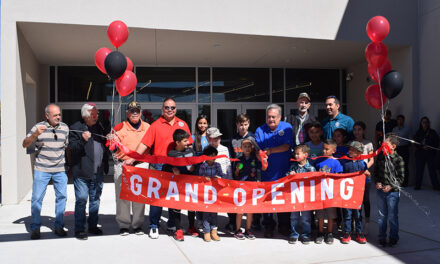He always knew he’d be history.
Growing up in the suburbs of New York City, Dr. Richard Melzer always had a love of history and teaching, knowing that eventually the two would converge.
At times, it seemed like he might take a different path in life, but spelling and rabbits had other ideas.
Last week, Melzer celebrated four decades of teaching history at the University of New Mexico-Valencia campus, and bid a fond farewell to colleagues and students as he stepped away from the grade book and into the next part of his life.

Dr. Richard Melzer talks to students and friends during his retirement party at the University of New Mexico-Valencia campus last week. For the last 40 years, Melzer taught numerous history and civics classes at the campus, with New Mexico history being the most popular.
Photo courtesy of UNM-Valencia
Melzer might be retiring from teaching but he won’t stop educating, he said.
“I speak all over the state, so this gives me a great reason to travel and write,” Melzer said. “I have four books in the works right now. People ask me how long it takes to write a book. I honestly don’t know; they’re all in process at the same time.”
His most recent project has been a trilogy of five books on the history of the Rio Abajo, compiled and written by himself and fellow historian John Taylor, and recently deceased writer, photographer and publisher, Baldwin “BG” Burr.
As he was finishing his undergraduate degree at Oswego State Teachers College — one of the State University of New York’s charter members — in 1971, Melzer was still on the fence. History was appealing but what about architecture?
“I decided to apply to the nearest architecture school, which was in Syracuse,” he said. “You had to fill out these forms, indicating which school you wanted to enter.”
The admissions team seemed impressed, telling Melzer a third of the students coming from Oswego had a 4.0 grade point average. Just as he thought he’d made it. They informed him he would have had a better chance at admittance if he’d spelled “architecture” correctly.
Sticking with history, Melzer went on to earn his master’s degree from Purdue in 1973, and his doctorate in Latin American History from the University of New Mexico in 1979.
In his final semester at UNM, Melzer needed someone to type his dissertation, a common occurrence of the time. He hired a woman for $1 a page — a rate he could scarcely afford.
Then he heard there was an opening for a western civilization teacher at a brand new campus in Valencia County. In 1978, the University of New Mexico-Valencia campus was in its infancy and housed at a shopping center in Rio Communities, affectionately dubbed the “fish bowl.”
Melzer took on the job of instructing five students during a night class, and he lived in terror it would be cancelled due to the low enrollment, leaving him unable to pay for the typing of his dissertation.
To make the class seem more popular than it apparently was, Melzer would make extra copies of tests.
“I would go to the front office and ask them to make 20 copies,” he said.
The person he was asking — Rena Chavez — was the registrar, finance director, jack-of-all-trades at the small campus, and knew very well he only had a handful of students.
Rena would marry Dr. Melzer in 1984, despite his attempt to inflate his enrollment numbers.
After graduating, thanks to a well-typed dissertation, in the spring of 1979, Melzer went on to teach at UNM-Valencia for 40 years in five decades — the 1970, ’80s and ’90s, then the 2000s and the teens of the new millennium.
Initially, he taught part-time and worked on the administrative side of the college, serving as the director of instruction for a few years.
He became a full-time instructor in 1983, but in 1988, he felt the yen to be elsewhere. Melzer flew to California and interviewed for a position at Long Beach College.
“I don’t know what they were doing, but when I got there, there were white rabbits everywhere. And I thought, ‘This is it. I’m supposed to be here,’” he said.
After a good interview, Melzer returned home to Valencia County, only to find the UNM-Valencia courtyard overrun with wild brown rabbits.
“I realized I could have everything I wanted right here,” he said with a smile.
Married to a Belen girl, with a long attachment to the history and culture of the area, and enamoured of his students, Melzer knew he was where he belonged.
“Oh, the students are so great. At first, I was just teaching night classes and it was mostly nontraditional, adult students,” he said. “There’s just something I love about teaching adults. At first, it was mostly people my own generation but that gap has gotten bigger over the years.
“And that’s not a criticism. The younger students are so excited, so dedicated, kind and polite. I’ve never had a problem. Maybe it was because of my weird classroom management practices.”
To keep order, Melzer implemented a system using yellow and red cards, similar to soccer. He could issue them to his students, they to each other and they could even give him a card.
On one occasion, he even gave himself a yellow card. A red card was never issued.
In four decades of instructing, New Mexico history is Melzer’s favorite and political science his least. As a teacher, he always tried to stay politically neutral, and not push his ideals on his students.
“That’s not fair. Sometimes you see it, a professor has a clear political leaning and students feel the need to line up with their political ideals,” he said. “I always wanted to see what the students thought. They can get caught up pleasing so many other people, especially the younger ones.”
Teaching New Mexico history gave Melzer a chance to introduce some students to their own, personal history, to have deep and meaningful connections to the community.
“I never thought of it as ‘town and gown.’ We’re a community college so we should have these ties,” Melzer said. “I realized it was part of my job, and I love it.
“To have this incredibly rich history and culture, and people willing to share it and trust this outsider, I love connecting it all. It was so cool to talk about something in class, then see students go home and tell their families and discover how their family fits into the larger picture.”
Melzer wasn’t entirely sure when he was going to retire, but this spring, some things fell in place.
“I appreciate my career. As time went on, I wanted to leave smoothly, and that’s what happened,” Melzer said. “My joy was being able to have a wonderful career.”
The professor notes, with some irony, the end of his teaching career came very much like the beginning. Fearful he would lose his job as a young teacher due to a lack of students in his class, Melzer found himself facing the same situation this semester.
“There weren’t enough students to justify a class,” he said with a laugh.
And so the bookends of history complete this part of his life.
Julia M. Dendinger began working at the VCNB in 2006. She covers Valencia County government, Belen Consolidated Schools and the village of Bosque Farms. She is a member of the Society of Professional Journalists Rio Grande chapter’s board of directors.

















